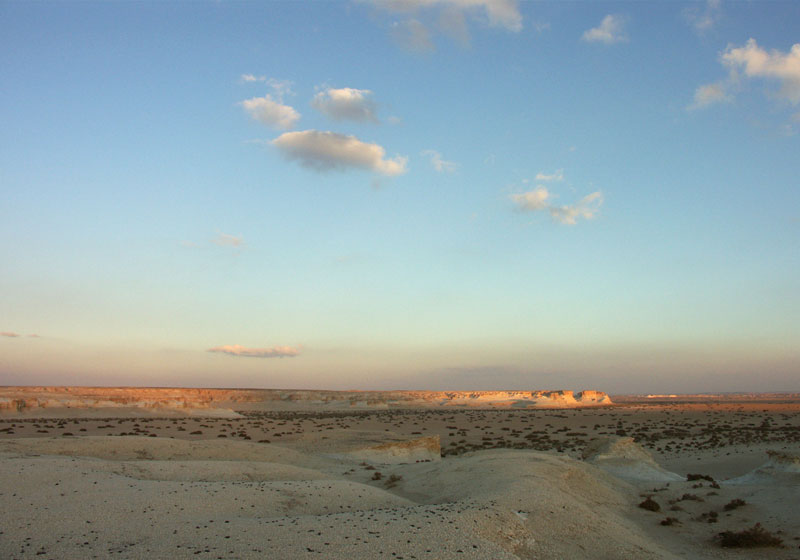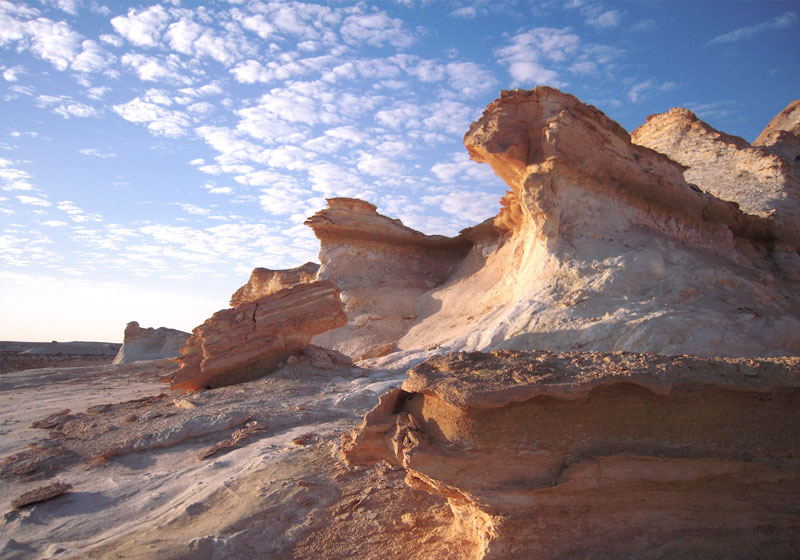Walking Whales

The name Qaa Faydat Ad-Dahikiya refers to a large canyon running from the northwest for about 8 km till it exits Jordan in the southeast. Ad-Dahikiya is a natural monument by all standards. From a distance, while driving in the seemingly flat desert, a vertical elevation starts to reveal itself, furnishing the horizon with a bright mass created by a limestone cliff. Within the golden ochre of the desert land it appears like a fresh brushstroke in titanium white. In a brusque edge, the land drops some 40 meters leaving you suspended on a cliff; the view is spectacular, presenting a good example of the many surprises the Jordanian desert holds in store for the adventurer.
Driving in a flat landscape for a long time alters your sense of vertical proportion. The endless horizontal land tampers with you visual calibration, often making your perception of any vertical elements clearly exaggerated. This visual phenomenon heightens the sense of surprise when approaching the Dahikiya edge, turning the arrival to this location into a pleasant shock; you’ve reached the edge of a flying carpet.

Created by two parallel faults some 3km apart, Dahikiya forms an enclosed valley walled in by cliffs on both sides. Towards Saudi Arabia these cliffs get further apart, diminish in height and loose sharpness. In the flat valley bed, natural gardens of aromatic desert shrubs create an environment of their own, woven in different greens, textures and invigorating aromas.
For Jordanian paleontologists Dr. Hakam Mustafa from Yarmouk University and PhD student Iyad Zalmout, now studying at the University of Michigan, the cliff is more important than the flat base. In a specific layer in this cliff, where rock turns grey due to the presence of organic material, Hakam and Zalmout carefully searched for shark teeth and other bone fragments. Like detectives or forensic experts, they piece together evidence of life and death in the remote past and in this geological section, events that happened some 45 million years ago. Using picks and sometimes brushes, the paleontologists collect specimens, wrap them in soft tissue and place them in bags marked with the location readings.
While collecting specimens during their fieldwork in 1998, the scientists suddenly made a discovery that heightened their excitement and rewarded them for their long toiling in the desert heat. A stone shaped like a cylinder slightly bigger than a soft drink can, and another one similar in shape but partially damaged were recognized within a lump of earth. Familiar with how zoology shapes matter they immediately recognized them as fossilized bones of some large vertebrate. At this moment thousands of mental images were called upon for comparison and the ever-growing files of the two scientists’ mental zoos were double-clicked open.
After cleaning, the better preserved bones have been identified as the 14 spine vertebrae of a prehistoric whale, “caudal 14 of Basilosaurus isis”. This specimen matched perfectly with other bones, from other parts of the world, of prehistoric whales paleontologists call archaeocete of the same period, the Eocene epoch (40 to 45 million years ago). This discovery represents “the first marine mammal from the Eocene of Jordan”. It sheds light on an environment of the paleo-shoreline of the “Tethys Ocean” that linked what is now the Arabian Gulf with the Mediterranean, submerging most of northern Jordan and almost all of Syria under water. On these paleo-shorelines, whales “walked” and swam in their wider habitat that reached all the way from Egypt to Pakistan where similar bones were discovered.
Ad-Dahikiya's secrets are slowly being unraveled, and the keen eyes and minds of the two Jordanian scientists are helping to place Jordan on the cutting edge of global scientific research. This location has contributed to the understanding of the evolution of sea mammals, our remote ancestors from the deep.
Drive to Azraq where you can get ice for the cooler and some extra thin wheat bread (shrak) prepared in the Druze tradition. Head south towards the border point with Saudi Arabia (Al-Umari), a few kilometers before, leave the paved road turning to your left heading northeast. After a relatively smooth off-road 4x4 drive for about 8 km, the big canyon is difficult to miss. For those with GPS, mark N: 31/37˚ 200, E: 37/07˚ 000. This destination is a wadi that extends into Saudi Arabia. Attention and good navigation skills are needed or you will get in trouble on the line between the two countries in the middle of the desert. As a full-day destination Ad-Dahikiya can be combined with other eastern desert attractions on the way to, and around Azraq.